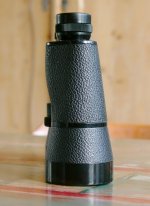Renze de Vries
Well-known member
Henry,
In post #4 you compared your mint Focalpin 7 to the Leitz 7x50 Marseptit. But only on one aspect. Could you elaborate some more on them? As we both happen to love large exit pupil binoculars (in fact you showed me the glorious path) maybe the Marseptit could be a good choice. I own a Leitz 8x30 Binuxit and if the Marseptit gives me comparable clarity, contrast and center sharpness I won't look any further.
best regards,
Renze
In post #4 you compared your mint Focalpin 7 to the Leitz 7x50 Marseptit. But only on one aspect. Could you elaborate some more on them? As we both happen to love large exit pupil binoculars (in fact you showed me the glorious path) maybe the Marseptit could be a good choice. I own a Leitz 8x30 Binuxit and if the Marseptit gives me comparable clarity, contrast and center sharpness I won't look any further.
best regards,
Renze





